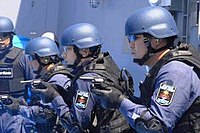New Nambu M60
| New Nambu M60 | |
|---|---|
| general information | |
| Country of operation: | Japan |
| Developer / Manufacturer: | Minebea |
| Manufacturer country: | Japan |
| Production time: | 1960 to 1999 |
| Model variants: | Two barrel lengths of 51 mm and 77 mm |
| Weapon Category: | Service weapon , revolver |
| Furnishing | |
| Overall length: | 197 mm |
| Total height: | 112 mm |
| Weight: (unloaded) | 0.680 kg |
| Sight length : | 104 mm |
| Barrel length : | 51, 77 mm |
| Technical specifications | |
| Caliber : | .38 Special |
| Possible magazine fillings : | 5 cartridges |
| Ammunition supply : | drum |
| Fire types: | Single fire |
| Number of trains : | 5 |
| Twist : | right |
| Visor : | open sights |
| Charging principle: | Multiple loaders |
| Lists on the subject | |
The New Nambu M60 revolver is a double-action revolver in .38 Special caliber , which was constructed according to Smith & Wesson designs.
The design and the original production are from Shin-Chuō Industries (Japanese 新 中央 工業), a company that merged with Minebea in 1975 . The name "New Nambu" comes from the renowned armorer Kijirō Nambu from the first half of the 20th century.
About 133,400 copies have been built since 1961. Production ceased in the 1990s, but the revolver is one of the standard service weapons used by Japanese law enforcement officers ( police and others, such as the coast guard ).
Historical background
In the period before World War II , most Japanese law enforcement agencies were equipped with only a saber. During the occupation after the war, the Supreme Commander for the Allied Powers arranged for these forces to be equipped with firearms. Since the arsenals of domestic weapons were insufficient, the Allies began issuing models of weapons to the Japanese police, which received service weapons leased from 1949 . Until 1951, all police officers were armed with handguns.
Initially there was a larger number of weapon models, although pistols of the type Colt M1911 and revolvers of the models M1917 , Smith & Wesson Military & Police and Colt Official Police were mainly carried as side arms. The .38 caliber revolvers were well received, but .45 caliber guns were too big for officers who tended to be smaller, especially women. In addition, the M1917 revolvers were outdated and clearly worn, with problems in reliability and accuracy. In response to these problems, some police authorities began (as one of the forerunners of the National Police Agency - the National Police Agency and some city police ), small arms in caliber .38 Special , like the revolver Smith & Wesson Chiefs Special and the Colt Detective Special to import. But due to the sheer number of weapons to be replaced and the prospect of industrial growth, the Ministry of International Trade and Industry (MITI) worked towards domestic arms production.
In 1957, weapons developments were initiated at Shin-Chuō Industries under the auspices of MITI . Three designs were researched at the same time: self-loading pistols each in .32 ACP and 9 mm Parabellum and revolvers in .38 Special . The New Nambu M57 comes from the pistol development , which was not transferred to series production. The revolver, known as the New Nambu M60 , met the requirements of the National Police Agency in a satisfactory manner and went into mass production from 1960.
Technical variants
The basic design of the revolver is based on the Smith & Wesson models "J-" and "K-Frame". The five-part drum is slightly larger than the drum of the S&W models; therefore their speedloaders cannot be used. The barrel has 5 turns with a right hand twist and an incline of 1 turn to 15 inches . There are known barrel lengths of 2 and 3 inches.
The trigger is designed as a DA / SA (Double Action / Single Action). When used with single action, the revolver has good precision, which allows shooting groups of 50 millimeters at a distance of 25 meters.
A variant of the revolver for sport shooters with a heavy, longer barrel and adjustable rear sight as well as an adjustable sport grip became known as the New Nambu M60 Sakura . The production of this variant was considered; however, it stayed with a few prototypes. Only 3 pieces of this model were exported to Europe.
Individual evidence
- ^ Ian Hogg: Jane's Infantry Weapons 1989-90 . 15th edition. Jane's Information Group, 1989, ISBN 0-7106-0889-6 , pp. 17 .
- ↑ Annual Report (Year ended March 31, 2015). (PDF; 1.4 MB) Minebea , July 2015, p. 8 , accessed on November 7, 2016 (English).
- ↑ Richard Jones: Jane's Infantry Weapons 2007-2008 . Jane's Information Group, 2007, ISBN 0-7106-2801-3 , pp. 289 .
- ↑ a b c d e f Satoshi Matsuo: New Nambu M60 . Ed .: Hobby Japan (= Gun Professionals ). September 2015, p. 80-85 .
- ↑ Eiji Takemae: History of the non-military activities of the Occupation of Japan, 1945–1951 . Ed .: Nihon Tosho Center. No. 15 , 2000, ISBN 978-4-8205-6537-6 , pp. 58 (Japanese).
literature
- Günter Wollert, Reiner Lidschun, Wilfried Copenhagen : small arms . (1945-1985). In: Illustrated encyclopedia of rifles from around the world . 5th edition. tape 1 + 2 . Brandenburgisches Verlagshaus, Berlin 1988, ISBN 3-89488-057-0 , weapons, p. 298-299 .
